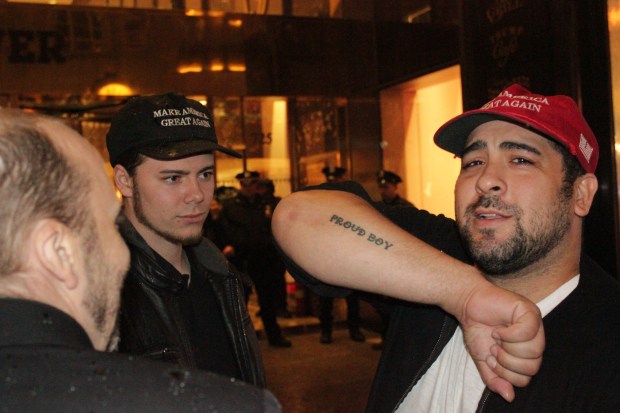On most weekdays for the past year and a half, Paul Rosa has stood outside across the street from Trump Tower on Fifth Avenue in Midtown holding protest signs and selling “NOT MY PRESIDENT” pins.
He said he’s been enraged since before the election and is surprised at how few New Yorkers are exercising their First Amendment rights.
“Protesting helps me vent my anger,” Rosa, 55, said. “People always ask, ‘What difference are you making?’ and I say, ‘Some.’ A snowflake starts an avalanche.”

On the anniversary of Donald Trump’s 2016 election victory, the upset felt by many that day still lingers. Though the massive marches have subsided, some remain motivated to take to the streets in protest.
Protests in general yield a variety of results. Whether large-scale like the Women’s March in January or small-scale like Rosa’s, protests help garner media coverage, build community and can give activists a sense of value even when the results of an election can’t.
“If political gain was the only thing to get out of protest, then we would have to judge most efforts as unsuccessful,” said Marc D. Dixon, an associate professor of sociology at Dartmouth and co-author of “Allies, Targets, and the Effectiveness of Coalition Protest”.
“Part of resistance protests are about building a more durable political movement, so that people do not tune out.”
Nearly 40 members of the Indivisible Brooklyn Do or Die resistance group lined the barricades in front of Trump Tower at 6:45 p.m. on Wednesday to mark the anniversary of the 2016 election with a protest. That’s far fewer than the thousands who gathered outside Trump’s New York home during the first weeks after the election.
Barbara Smucker, a Long Island resident and a member of Do or Die, said she finds it hard to think about Hillary Clinton’s defeat but believes doing so is crucial for the continued momentum of resistance to the Trump administration.
“I feel inside I just have to,” said Smucker, 59, about coming out to protest on a rather cold night. “I feel like a lot of people have given up, and that’s sad.”
Joy, a Brooklyn resident who would not give her last name, disagreed. She has seen membership in her local democratic social club double in the past year and said she was inspired by the gains made by the Democrats in Tuesday’s elections.
“We saw what happened when we weren’t effective,” she said. “Now we are realizing what we need to do on a local level.”
Minutes after the Do or Die coalition arrived, five Trump supporters emerged from the building, dressed in red, wearing “Make America Great Again” hats and waving pro-Trump flags. Shouts and jeers were exchanged between the groups. Some conversations were heated but ideas were traded along with insults and profanity. Yet, protesters remained civil.
Another Trump supporter, Salvatore Cipolla lit a cigarette and stood on the edge of the sidewalk in front of Trump Tower. He’s a member of the Proud Boys, a far-right men’s organization, and was sporting a freshly-inked tattoo with the group’s moniker on his left forearm.
“I don’t think protests are effective,” Cipolla said, surrounded by three friends, also Trump supporters. “Why do we need to protest? We won. Unless it’s huge on social media or arrests, what’s the point?”

While social media and its rapid-fire way of spreading information has been beneficial for activists targeting political figures and holding them accountable, some experts say that protesting in person extends effectiveness.
“Protests over the past year have reaffirmed that taking a stand, literally, has value as an extension of social-media campaigns that may otherwise seem self-fulfilling rather than oppositional,” Carolyn Kitch, a professor of journalism at Temple University who has studied public political memory, said in an email.
For some, physically showing up feels more effective than interactions on Twitter with a 280-character limit.
Colleen Cunningham, who attended the Women’s March in Washington D.C. in January and was at Trump Tower Wednesday night, said the larger protest had “more tangible” value while smaller protests open more opportunities for “conversations with the other side.”
Michael R., a Manhattan resident who preferred to only give his last initial, had two fairly tense conversations about immigration with Trump supporters throughout the protest and was not optimistic about the impact.
“We aren’t going to change their minds,” he said. “The inherent value of having these conversations is understanding people different than yourself.”
